Mont Saint-Michel: Normandy’s sandcastle in the sky is Disney worthy but watch your step
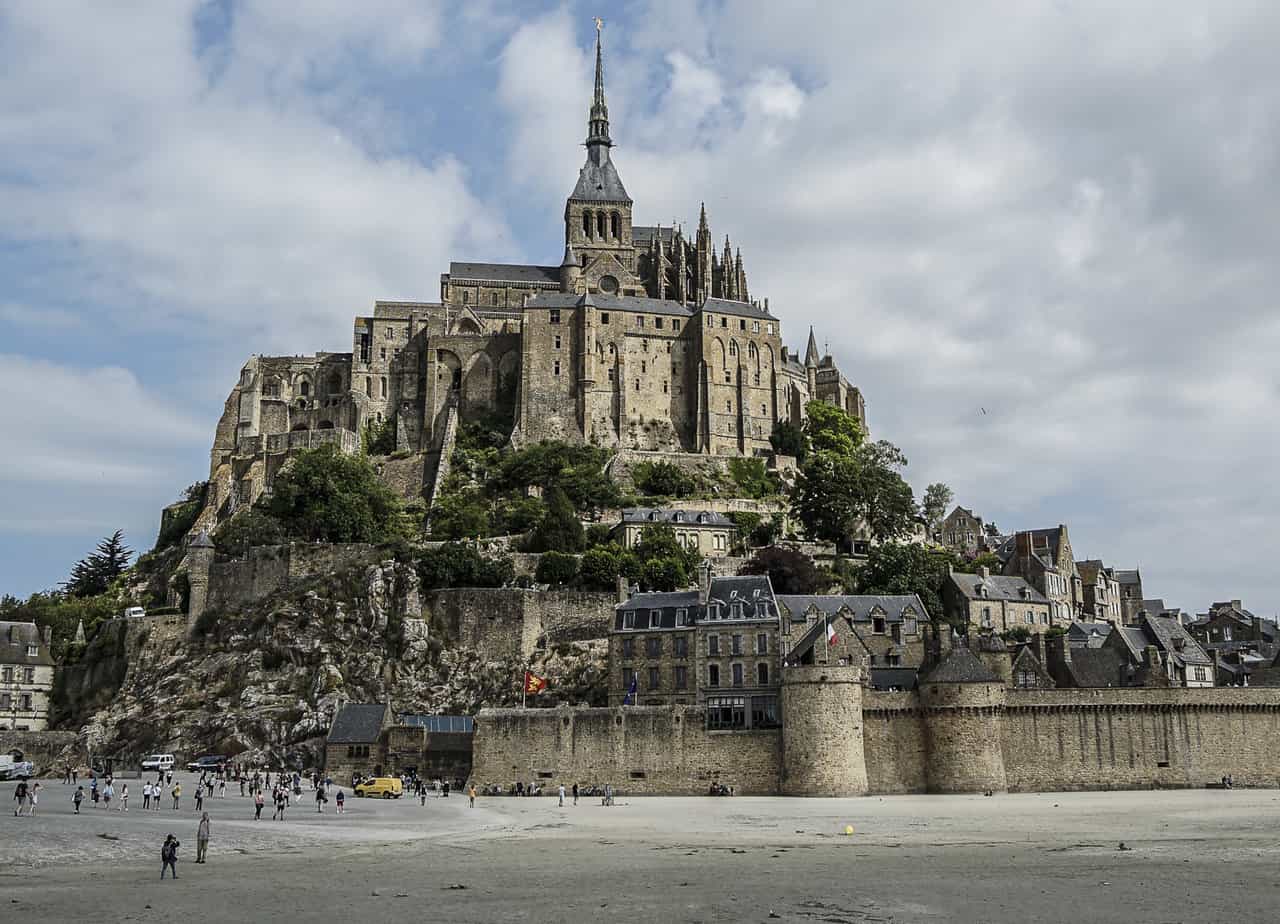
(This is the second of a three-part blog on Normandy.)
MONT SAINT-MICHEL, France – Nearly every morning when I travel I have a routine. I wake up and check the weather to know what to wear. I check the transportation timetable to know when to leave. But one place in Normandy had me checking something for my first time.
The tides.
“Let’s see,” said our hotel clerk as she gazed at a big table of figures hanging on a wall. “It’s June 22. It’s low tide. You’re safe.”
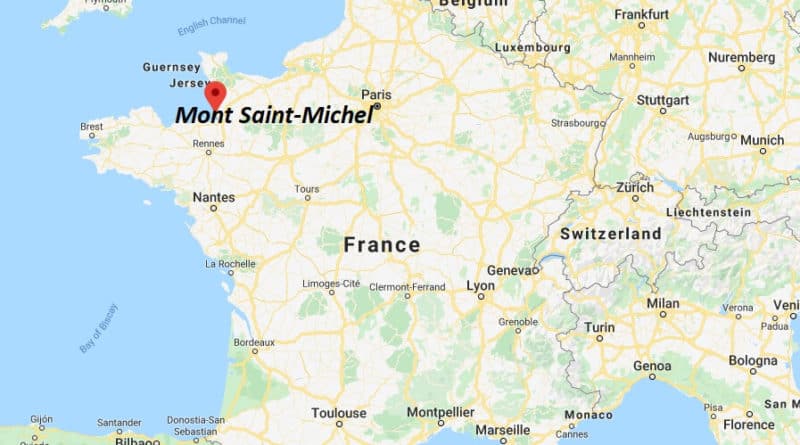
Tide tables hang in hotels in the west end of Normandy, where Mont Saint-Michel Bay leads up to the Channel Islands. You need to know tides if you’re going to visit one of the most popular tourist attractions in France. Pick the wrong time and you could get swept out to sea.
Now that would be a travel day from hell.

Mont Saint-Michel, a UNESCO World Heritage Site since 1979, is strange. It’s magnificent. It’s inexplicable. It’s beautiful. It’s garish. It’s breathtaking. It’s cartoonish. It’s gargantuan. Add it all up and what started out as a little chapel in the 8th century is one of the planet’s most amazing sights.
It’s often described as a sandcastle that rises from the sea. Actually, at first glance it looks like part of Disneyland Paris got annexed to France’s northern shore. Walking through it among the flesh of tourists, you think you’ll turn the corner and see a line for the Pirates of the Caribbean ride.
Why Mont Saint-Michel?
We came here to fill Marina’s lifelong dream. A Catholic from Rome – a true Roman Catholic – she had read about Mont Saint-Michel since she was a little girl. The spires. The views. The history. I took her here for her birthday and found a hotel in little Ducey, just 10 miles (17 kilometers) from the site.
Ducey is the smallest town we’ve ever slept in. It has 2,750 residents. Mont Saint-Michel is the smallest town we’ve ever visited. It has 35 residents. But Mont Saint-Michel doesn’t have that small-town French feel where you grab a bottle of Bordeaux, some Camembert and a baguette and head off to a quiet picnic.
Three million tourists a year kinda spoil the mood.
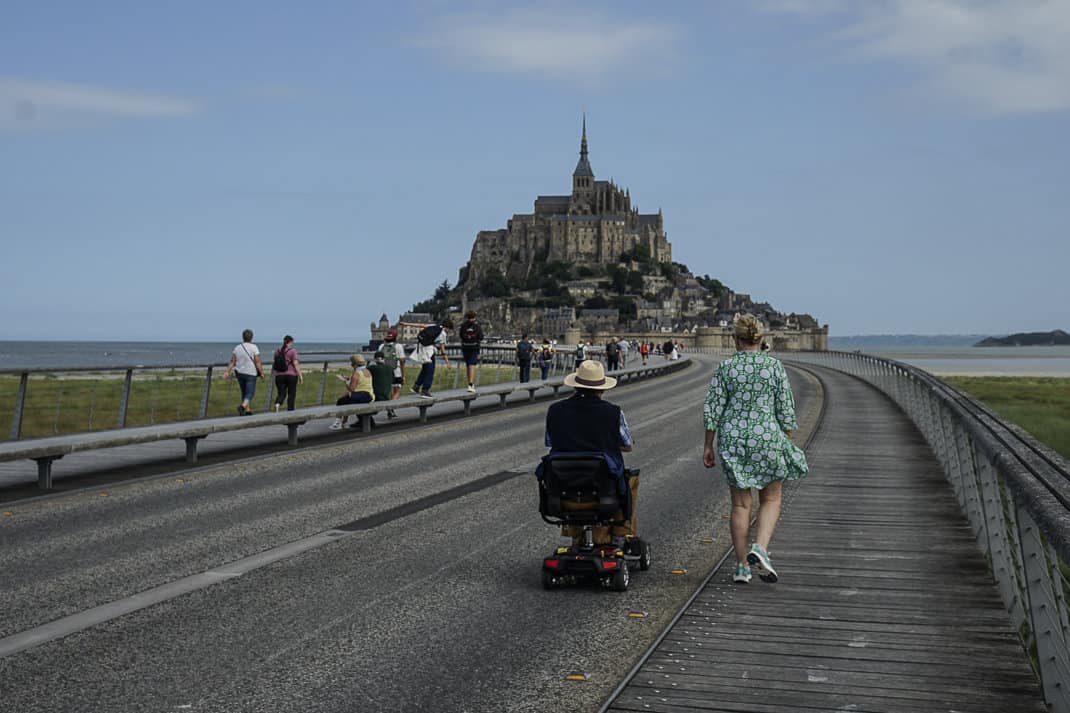
The arrival
Nevertheless, we joined the throng on one perfect French June morning. The short drive from Ducey wasn’t 10 minutes old when we first saw it. It was flat nothingness. Just tall grass and taller yellow shrubbery. Then behind it, rising like a spaceship, was a giant spire pointing toward the heavens surrounded by smaller spires atop a castle.
The sand-colored stone really does make it look like a giant toddler on spiked Cap’n Crunch ran amok with sand and a shovel. But it’s real. The closer we got the more majestic it appeared.
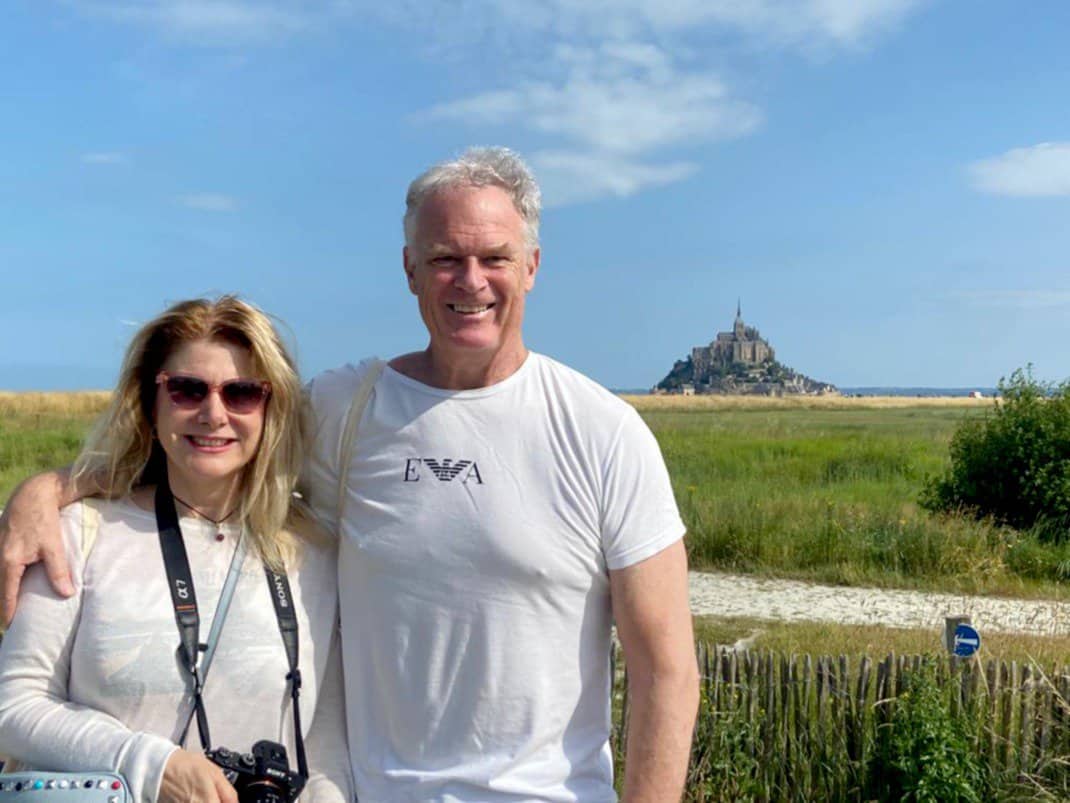
We parked in a lot bigger than De Gaulle Airport’s. A line five deep stretching about half a kilometer waited for shuttle buses to carry them the mile and a half (2.7 kilometers) to the entrance. We walked the paved path with people taking photos with the mountain in the background about every 10 minutes. We walked by an old man playing a flute for spare change.
The tide table was accurate. The bay was at very low tide. The water barely crept up the shore. Below Mont Saint-Michel was barren sand where the sea often comes. It was like walking across a damp desert.
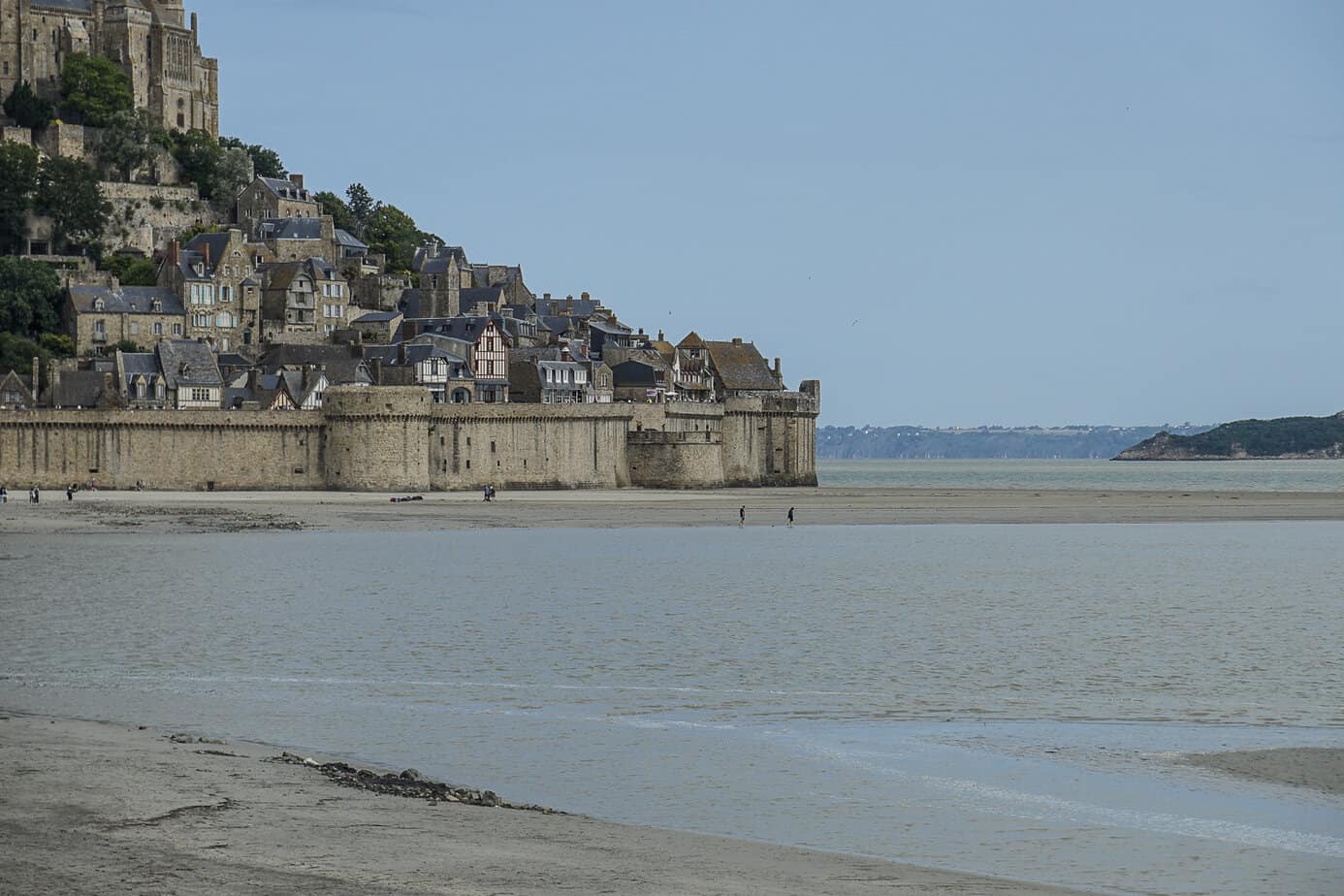
The tides
This is the site of one of the planet’s oddest phenomena. Mont Saint-Michel Bay has Europe’s highest tidal variations. In only six hours, the tides can climb to 50 feet (15 meters) and completely surround the site which also serves as a dam. It only happens every month or two but the waters come in at the rate of a small tsunami. Tourists trying to circumnavigate the site, measuring a kilometer in circumference, can be overtaken by the tide or by water carrying accumulated sediments that pour out of the dam’s eight gates.
Even at low tide it can be dangerous. The famous Bayeux Tapestry up the coast depicts a scene of Norman soldiers getting stuck in the wet sand surrounding the mountain.
What nimrod decided to build a chapel here?
The history
His name was Bishop Aubert of Avranches. In 708, the Archangel Michael appeared in the dreams of Saint-Aubert, bishop of Avranches, just 15 miles (24 kilometers) to the south. Aubert claims Michael told him to build a sanctuary in his name on the summit of the island.
He built just a wee church, a place to accompany a few worshipers who had strong devotion and stronger legs. In 966 Richard I, Duke of Normandy, gave it to the Benedictines who made it into a learning center. In the 11th century they converted it into a fortress complete with an armory to fend off invading armies, particularly those medieval jerks, the English.

In the Hundred Years War between the French and English, Mont Saint-Michel turned back three assaults and became the only spot in western and northern France not to be conquered. After the French Revolution, it became a prison and in the 18th century, as the mountain became built up under the chapel, they traded fear for francs and tourism became the focus.
Entering through the arch
Which is why after we walked under the large arched entryway, we were gobsmacked by culture shock. From the vision of walking into a time machine back to Medieval France, we instead walked into Free Sunday at Disneyland. Cheek to cheek, elbow to elbow, we joined a thick wave of tourists negotiating the narrow cobblestone walkway up the mountain.

We stop-and-go walked by crepes shops and souvenir shops and art shops. One self-catering machine sold pizza by the slice. We passed Hotel Les Terrasses Poulard with rooms starting at €282 a night.
Children screamed and cried. Backpackers cursed. Marina and I huffed and puffed. On a stone wall, a seagull stood content and calm with the bay just as tranquil in the background.

It’s a long haul to the top where the abbey is the main attraction. But numerous points of interest dot the walk. I paid a small fee to enter the prison, which by the time it closed in 1863 had housed 14,000 prisoners. Upon arrival, they were told, “Get a good look at the beautiful view. It’ll be the last time you’ll see it.” Also, “Don’t plan on escaping, unless you know how to negotiate murderous tides and quicksand.”
Today the prison is eerily lit and without a single window looking out to the sea. One cell has a partially clothed skeleton. Another showed two nattily dressed prisoners holding straw, which prisoners made into hats, chairs and pictures. Another showed Francois Raspail, a politician who chose the wrong side of the French Revolution and had a long-term lease in the prison from 1830-48. Rehabilitation obviously worked. He was later appointed senator of Paris.
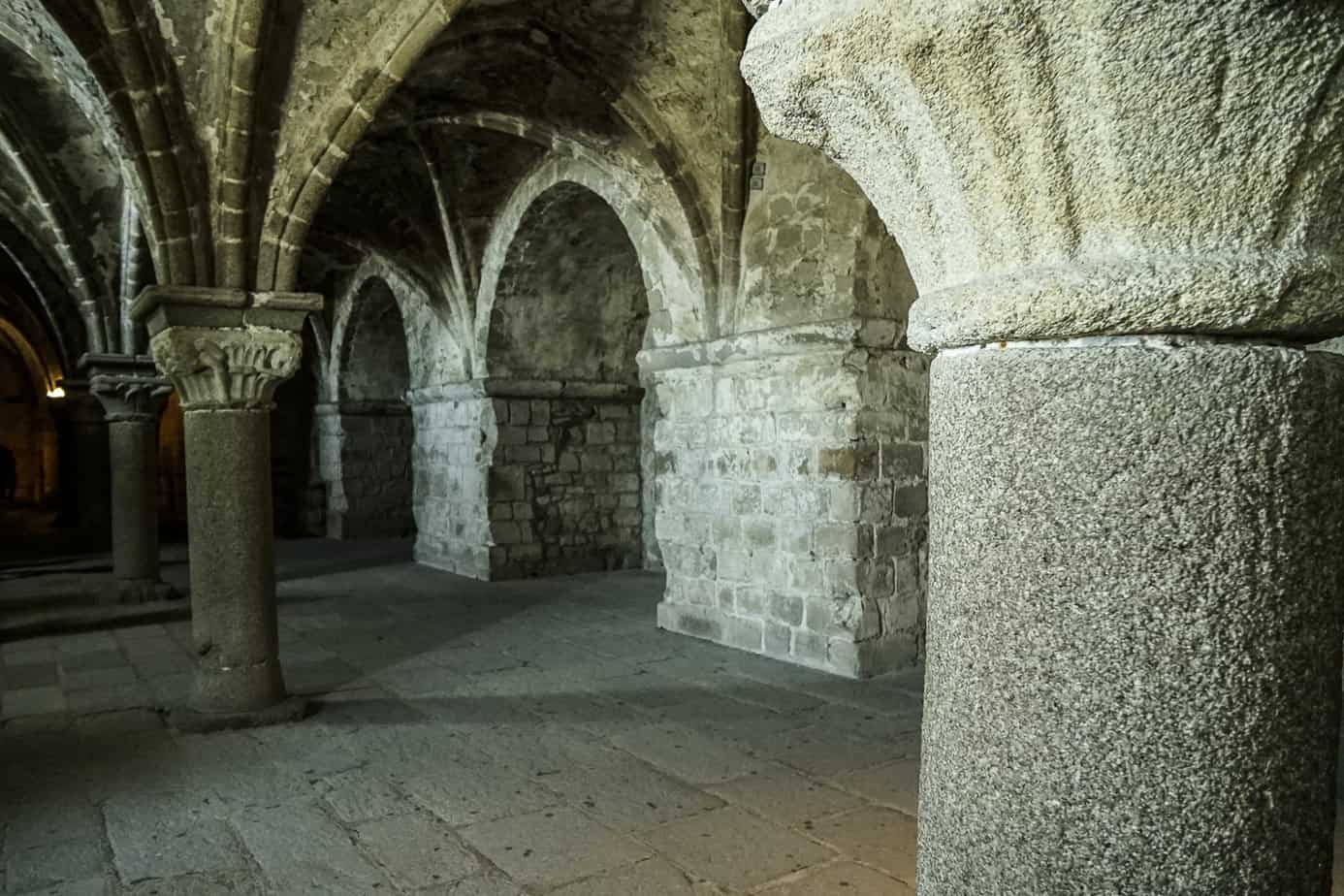
The path up the hill is a maze of alleys, one only 20 inches (50 centimeters) wide. But they all lead to the abbey which has some of the best views in Northern France. We could see as far as the horizon with the bay on one side and a green and yellow grid of farmland on the other. The abbey’s spire towered above us 550 feet (167 meters) above the bay.
The weather was ordered from a traveler’s dream: 72 degrees, bright sun with a cool breeze coming off the water. Despite the crowds, the sun and the climb, we never sweated.
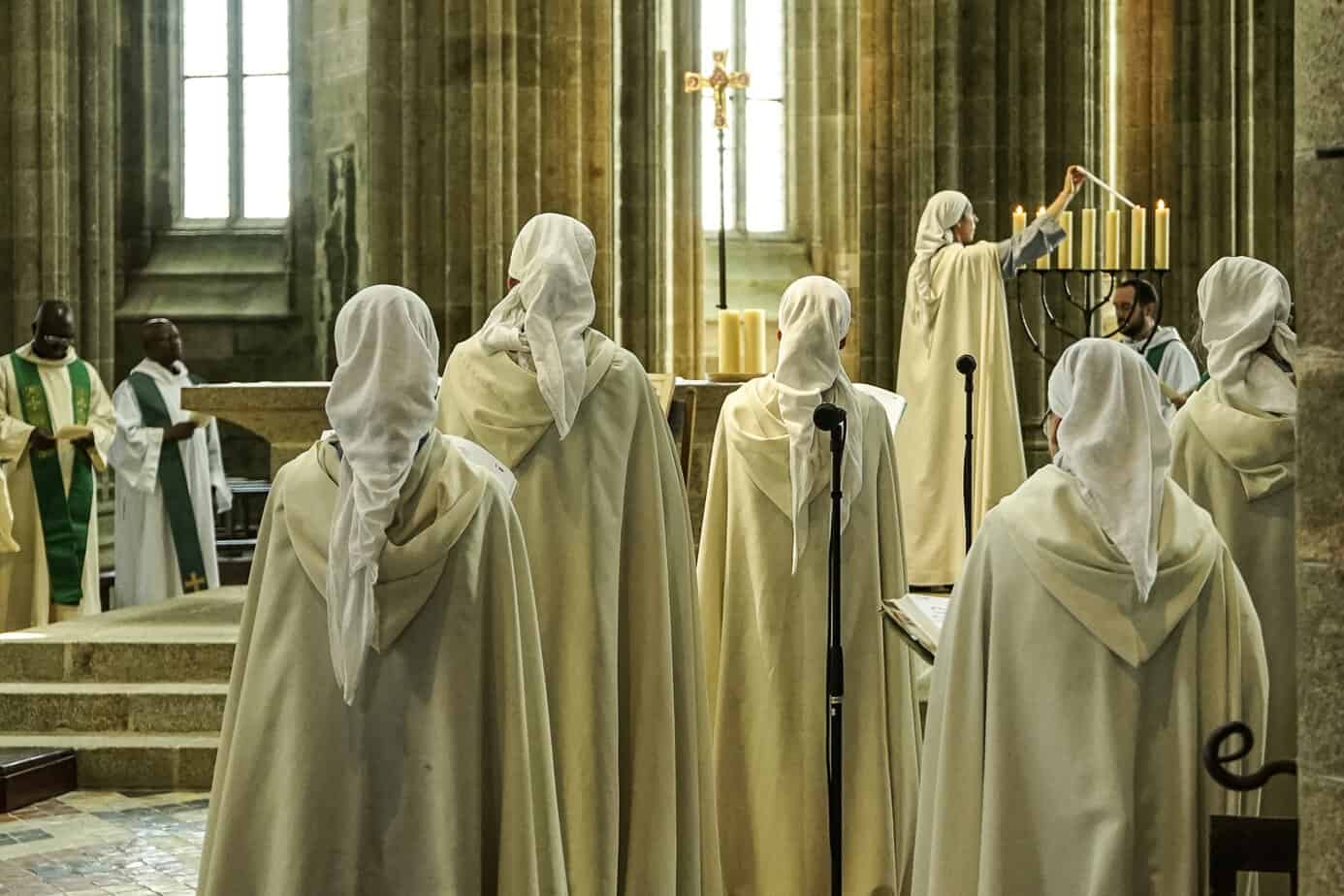
Noon mass
The timing of our arrival also could not have been better. We arrived at the abbey at noon, an hour after we entered the archway. We joined others who packed the large church and watched 20 of the town’s 35 residents put in their workday.
Benedictine monks of various races in white robes with green trim entered and formed a line at the side. A nun approached and kneeled. A bald, bearded monk in a long green robe then entered and gave a sermon with Marina singing along with the hymns. A nun came over and shook the hand of everyone in our row.
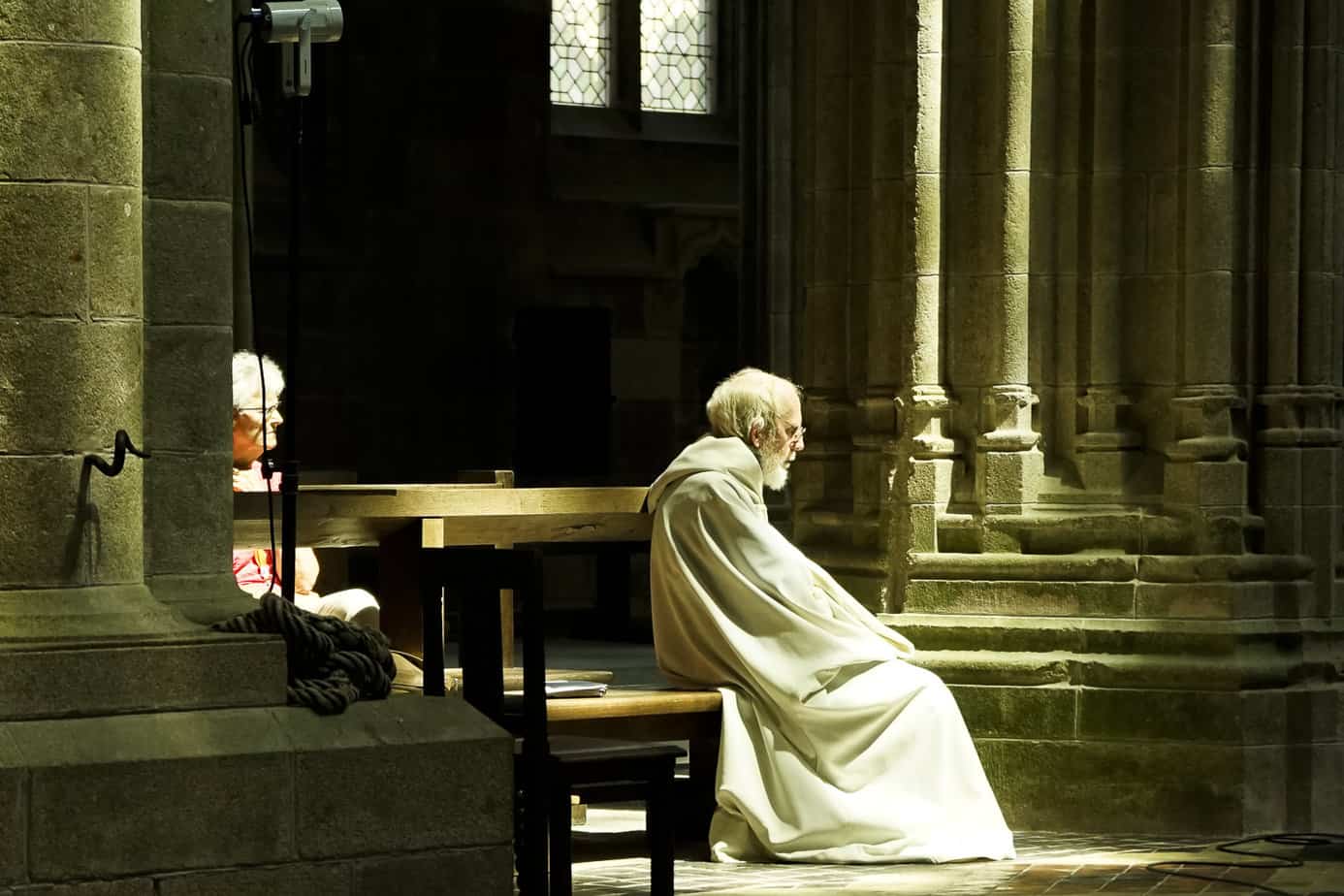
I’m not religious but standing in one of the world’s most iconic abbeys with the view of gorgeous Normandy on a sunny summer day right outside the door, I did feel blessed. Also, Marina fulfilled her lifelong dream.
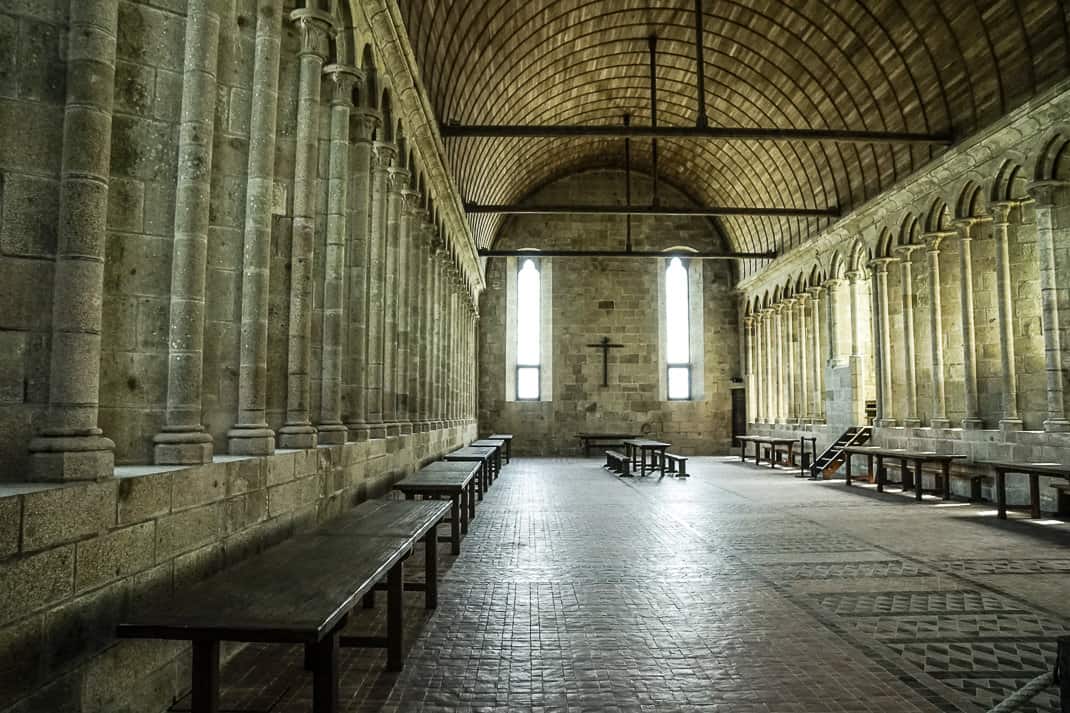
We wound our way down from the abbey, passing the Knights Hall, surrounded by dozens of arches around a space used since the 13th century for studying and quiet compilation. We passed the Cloisters, a wide-open grassy area enclosed by arches of granite, stone and marble. In the middle of the maze of staircases, we passed a giant wheel prisoners walked on to hoist supplies to the upper reaches of the town.
On the way out, I caught glimpses of simple doors with no signs indicating what they offered tourists. These were apartments for some of the 35 residents who, a woman at the tourist center said, “have lived here for centuries.”
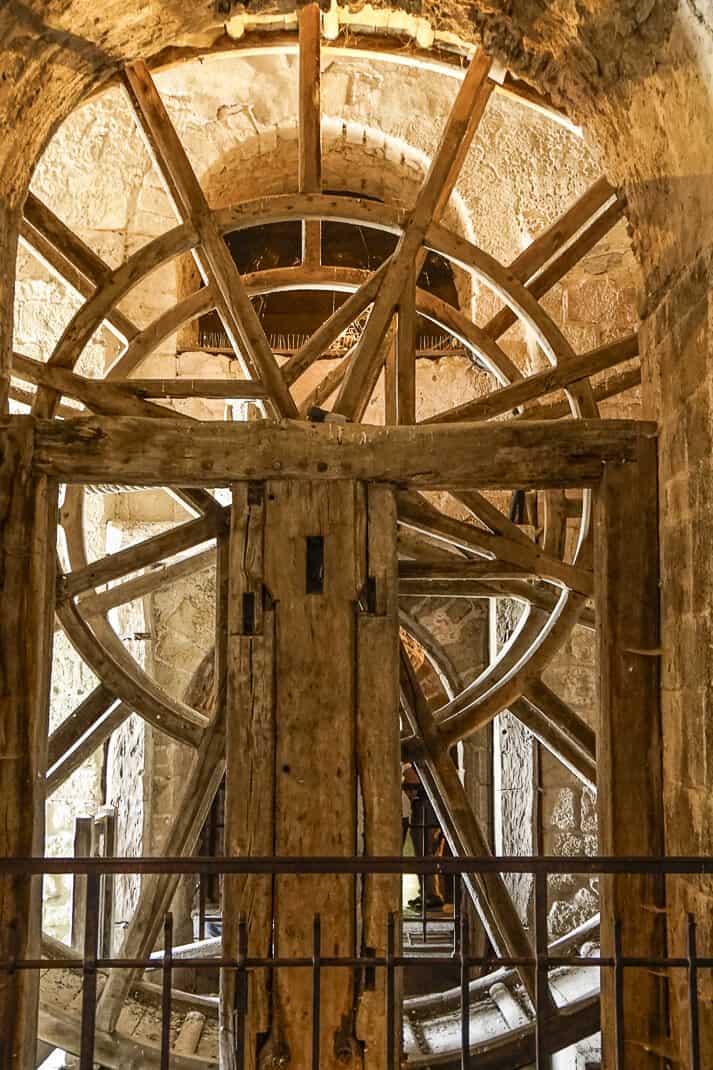
Before leaving, Marina and I stood on one of the ramparts, looking out at the wet sand and sea beyond. The tide still hadn’t come in yet. We had plenty of time to walk to the car. Seagulls stared at us from various stone walls. The cool breeze felt like a massage as the sun sparkled off the sand.
Aubert, you did good. Michael would be proud.
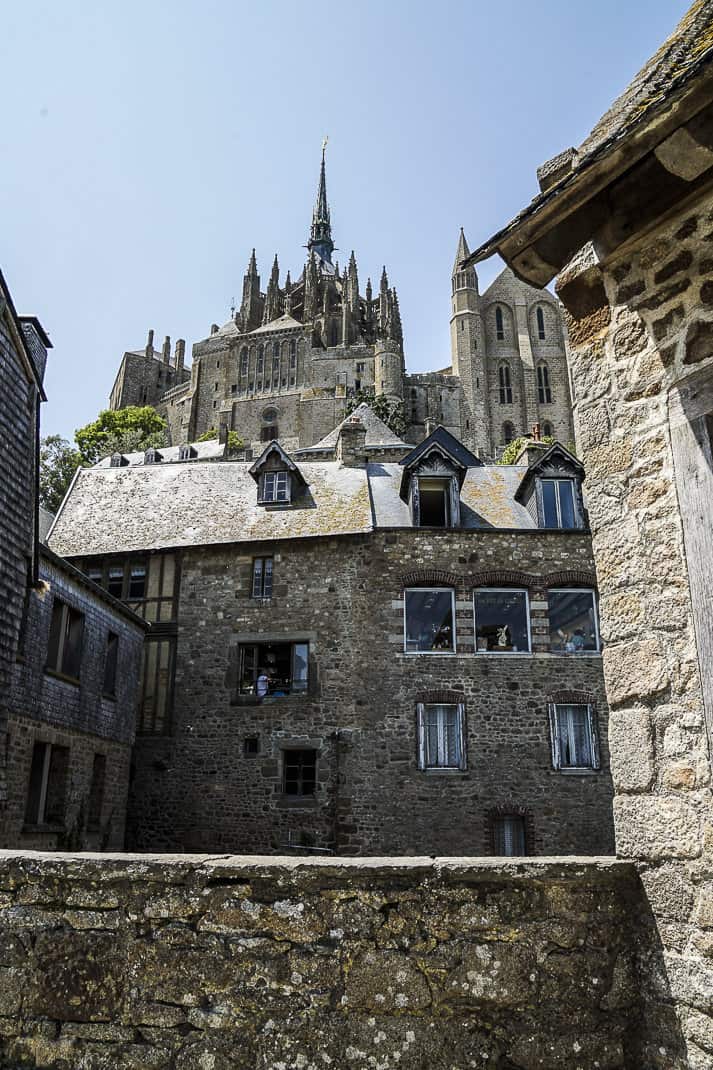
If you’re thinking of going …
How to get there: The closest airport to Mont Saint-Michel is in Rennes, 40 miles (75 kilometers) to the south and can be reached by a connection from Paris’ Charles De Gaulle Airport. Depending on your arrival date, the connection can be expensive. It could be cheaper to fly to De Gaulle Airport and take one of the half dozen daily trains to Rennes. The three-hour trip starts at €29 one way. From Rennes, take a €5 train 50 minutes to Pontorson, four miles south of Mont Saint-Michel’s parking area.
How to go: Entrance to the abbey was €25 for two tickets. Pay at the ticket center halfway up.
Where to stay: Best Western Le Moulin de Ducey, 1 Grande Rue, Ducey, 33-02-33-60-2525, https://moulindeducey.com/en/homepage/. Spotless, comfortable hotel next to the famous 17th century stone bridge which led pilgrims to Mont Saint-Michel, 10 miles (17 kilometers) to the north. Excellent slice of French country living. However, you need a car to reach Mont Saint-Michel as Ducey has no train station. I paid €540 for four nights including a terrific buffet breakfast.
Where to eat: Le Ducèen, 27 Grande Rue, Ducey, 33-02-33-89-7276. Features a long list of galette, a Creole crepe filled with a variety of ingredients from chocolate to cheese. Nice patio on Ducey’s quiet main street. Dinner for two was 43 euros.
When to go: Except for Scandinavia, I advise everyone to avoid anywhere in Europe in July and August due to the crowds. Being on the sea, Mont Saint-Michel has mild temperatures. Average highs are 71 in July and August and 46 in February.
For more information: Mont St-Michel Tourist Office, Grande Rue, 33-02-33-60-1430, www.ot-montsaintmichel.com, tourisme.lemontsaintmichel@msm-normandie.fr, 9:30 a.m.-7 p.m. July-August; 10 a.m.-5 p.m. November-March; 9:30 a.m.-6:30 p.m. Monday-Saturday, 9:30 a.m.-6 p.m. Sunday, April, May, June September; 9:30-5:30 p.m. Monday-Saturday, 9:30 a.m.-5 p.m. Sunday, October. It’s just to the left after you enter. The La Caserne Tourist Office is also at the car park.


July 14, 2023 @ 12:13 pm
I was in awe when I saw it. It’s a magical place. Luckily I saw it with few tourists (I was surprised by the photo with the crowd) and I stayed at a hotel very close to the “causeway” so I could walk there anytime.
What a nice gift for her birthday. Perfect place.
July 15, 2023 @ 10:47 am
Thanks, Carol. You were lucky with the tourists. What month and at what time of day did you go? We were told to go early in the morning. I can’t imagine going there now.